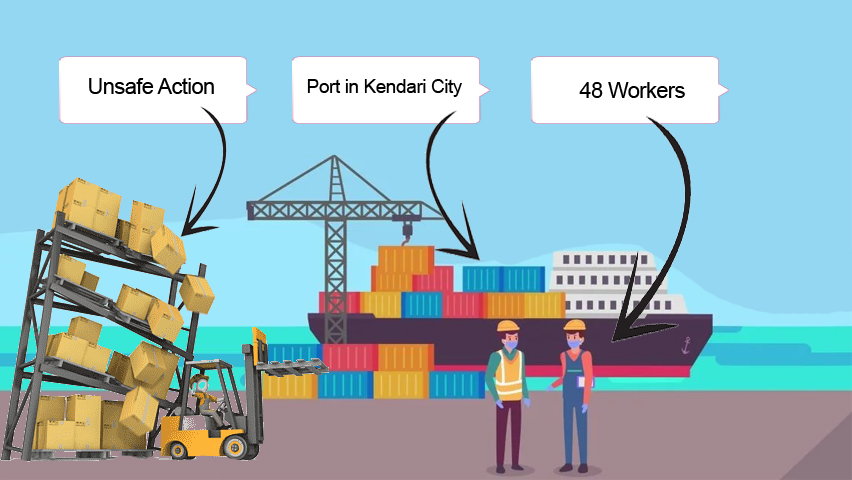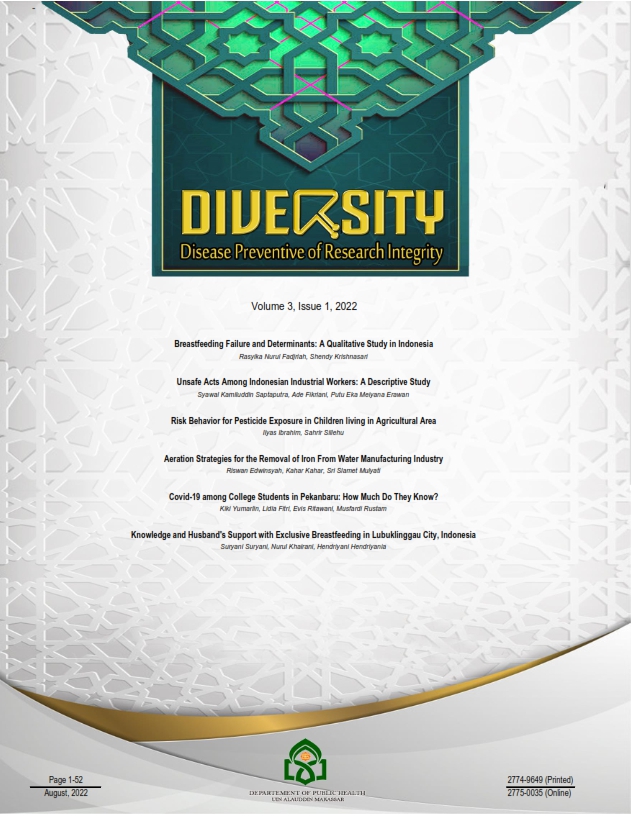Unsafe Acts Among Indonesian Industrial Workers: A Descriptive Study
Abstract
Unsafe action is a human failure to follow the correct work requirements and procedures, causing work accidents. The aim of the study was to describe the unsafe acts of loading and unloading workers at PT. X in Kendari City. The type of study was quantitative research with a descriptive observational approach. This study only looks at the unsafe acts carried out by workers by using observation sheets in the form of checklists and questionnaires. The number of samples was determined by a total sampling of 48 people. The results of this study used the univariate analysis method, where it was found that the results of Unsafe Action, the type of unsafe action that is most often carried out by workers at was the improper use of Personal Protective Equipment. In addition, there was the operation of Lift-and-Transport equipment at speeds that are not in accordance with the SOP, as well as the arrangement of containers outside the stacking field. Loading and unloading workers who act unsafely are at high risk of work accidents that can cause injury, lost working days, and decreased productivity. It is hoped that the PT. X Kendari City to improve supervision of the use of Personal Protective Equipment (PPE) for workers as an effort to control work accidents.

Downloads
References
Al-Damasyqi, (2007). I. A. I. I.U. I. K. Tafsir Ibnu Katsir Jilid 4 : Tafsir Al-qur'an Al-adzim / Imaduddin Abi Fida' Ismail Ibn Umar Ibn Katsir Al-Damasyqi .
Alvernia, P. S., Kurniawan, B., & Lestantyo, D. (2018). Analisis Faktor-Faktor Yang Mempengaruhi Keselamatan Pengoperasian Alat Angkat Bongkar Muat Peti Kemas (Studi Kasus di PT. Pelabuhan Tanjung Priok). Jurnal Kesehatan Masyarakat (Undip), 6(4), 353-360. https://doi.org/10.14710/jkm.v6i4.21439
Anthony, M. B. (2018). Persepsi antara Risiko Keselamatan Berkendaraan dengan Perilaku Pemakaian Safety Belt pada Driver Truk. Jurnal INTECH Teknik Industri Universitas Serang Raya, 4(2), 53-58. https://doi.org/10.30656/intech.v4i2.927
As-Suyuthi, J., & Al-Mahalli, J. (2003). Tafsir jalalain. Surabaya: Imaratullah.
Badri, A., Boudreau-Trudel, B., & Souissi, A. S. (2018). Occupational health and safety in the industry 4.0 era: A cause for major concern?. Safety science, 109, 403-411. https://doi.org/10.1016/j.ssci.2018.06.012
BPJS Ketenagakerjaan Kendari. (2020). Data kecelakaan kerja kota kendari dan Indonesia tahun 2015-2020. Kendari
Chen, C., Reniers, G., Khakzad, N., & Yang, M. (2021). Operational safety economics: Foundations, current approaches and paths for future research. Safety science, 141, 105326. https://doi.org/10.1016/j.ssci.2021.105326
Chen, J. C., & Vincent, F. Y. (2018). Relationship between human error intervention strategies and unsafe acts: The role of strategy implementability. Journal of Air Transport Management, 69, 112-122. https://doi.org/10.1016/j.jairtraman.2018.02.009
Fruhen, L. S., Griffin, M. A., & Andrei, D. M. (2019). What does safety commitment mean to leaders? A multi-method investigation. Journal of safety research, 68, 203-214. https://doi.org/10.1016/j.jsr.2018.12.011
Guo, S., Zhou, X., Tang, B., & Gong, P. (2020). Exploring the behavioral risk chains of accidents using complex network theory in the construction industry. Physica A: Statistical Mechanics and Its Applications, 560, 125012. https://doi.org/10.1016/j.physa.2020.125012
Hudson, P. (2014). Accident causation models, management and the law. Journal of Risk research, 17(6), 749-764. https://doi.org/10.1080/13669877.2014.889202
International Organization for Standardization. (2018). ISO 45001:2018: Occupational health and safety management systems requirements with guidance for use. Geneva, Switzerland. https://www.iso.org/standard/63787.html
Islam, R., Hossain, M. S., & Siddique, M. A. B. (2017). Occupational health hazards and safety practices among the workers of tannery industry in Bangladesh. Jahangirnagar University Journal of Biological Sciences, 6(1), 13-22. https://doi.org/10.3329/jujbs.v6i1.33727
Khan, M. W., Ali, Y., De Felice, F., & Petrillo, A. (2019). Occupational health and safety in construction industry in Pakistan using modified-SIRA method. Safety science, 118, 109-118. https://doi.org/10.1016/j.ssci.2019.05.001
Lady, L., Marliana, P., & Umyati, A. (2014). Kajian kecelakaan kapal di pelabuhan Banten menggunakan human factors analysis and classification system (HFACS). Jurnal Rekayasa Sistem Industri, 3(2), 46-52. https://journal.unpar.ac.id/index.php/jrsi/article/view/1296
Lam, J. S. L., & Su, S. (2015). Disruption risks and mitigation strategies: an analysis of Asian ports. Maritime Policy & Management, 42(5), 415-435. https://doi.org/10.1080/03088839.2015.1016560
Liu, R., Cheng, W., Yu, Y., Xu, Q., Jiang, A., & Lv, T. (2019). An impacting factors analysis of miners' unsafe acts based on HFACS-CM and SEM. Process Safety and Environmental Protection, 122, 221-231. https://doi.org/10.1016/j.psep.2018.12.007
Mahachandra, M., & Avviantari, V. (2018). Evaluasi Safety Critical Event Pengemudi Bus Untuk Meminimasi Kecelakaan Lalu Lintas. J@ti Undip: Jurnal Teknik Industri, 13(2), 83-90. https://doi.org/10.14710/jati.13.2.83-90
Nam, T. (2019). Technology usage, expected job sustainability, and perceived job insecurity. Technological Forecasting and Social Change, 138, 155-165. https://doi.org/10.1016/j.techfore.2018.08.017
Nath, N. D., Behzadan, A. H., & Paal, S. G. (2020). Deep learning for site safety: Real-time detection of personal protective equipment. Automation in Construction, 112, 103085. https://doi.org/10.1016/j.autcon.2020.103085
Novianto, N. D. (2015). Penggunaan Alat Pelindung Diri (APD) Pada Pekerja Pengecoran Logam PT. Sinar Semesta (Studi Kasus Tentang Perilaku Penggunaan Alat Pelindung Diri (APD) Ditinjau Dari Pengetahuan Terhadap Potensi Bahaya Dan Resiko Kecelakaan Kerja Pada Pekerja Pengecoran L. Jurnal Kesehatan Masyarakat (Undip), 3(1), 417-428. https://doi.org/10.14710/jkm.v3i1.11460
Pratama, A. K. (2015). Hubungan karakteristik pekerja dengan unsafe action pada tenaga kerja bongkar muat di PT. Terminal Petikemas Surabaya. The Indonesian Journal of Occupational Safety and Health, 4(1), 64-73. https://doi.org/10.20473/ijosh.v4i1.2015.64-73
Ridasta, B. A. (2020). Penilaian Sistem Manajemen Keselamatan dan Kesehatan Kerja di Laboratorium Kimia. HIGEIA (Journal of Public Health Research and Development), 4(1), 64-75. https://journal.unnes.ac.id/sju/index.php/higeia/article/view/33891
Sætrevik, B., & Hystad, S. W. (2017). Situation awareness as a determinant for unsafe actions and subjective risk assessment on offshore attendant vessels. Safety science, 93, 214-221. https://doi.org/10.1016/j.ssci.2016.12.012
Safitri, F. D., & Widajati, N. (2019). The Correlation between Knowledge, Attitudes toward Occupational Safety and Health and Near Miss. The Indonesian Journal Of Occupational Safety and Health, 8(3), 328-335. https://doi.org/10.20473/ijosh.v8i3.2019.328-335
Saputro, S. S. (2015). Penentuan Jenis Alat Bongkar Muat Kapal Ketika Stevedoring Studi Kasus PELINDO III Tanjung Perak (Doctoral dissertation, Institut Technology Sepuluh Nopember). https://repository.its.ac.id/71916/
Senjayani, S., & Martiana, T. (2018). Penilaian dan Pengendalian Risiko Pada Pekerjaan Bongkar Muat Peti Kemas Oleh Tenaga Kerja Bongkar Muat Dengan Crane. Journal of Public Health Research and Community Health Development, 1(2), 120-130. https://doi.org/10.20473/jphrecode.v1i2.16244
Shakerian, M., Jahangiri, M., Alimohammadlou, M., Nami, M., & Choobineh, A. (2019). Individual cognitive factors affecting unsafe acts among Iranian industrial workers: An integrative meta-synthesis interpretive structural modeling (ISM) approach. Safety Science, 120, 89-98. https://doi.org/10.1016/j.ssci.2019.06.041
Shin, M., Lee, H. S., Park, M., Moon, M., & Han, S. (2014). A system dynamics approach for modeling construction workers’ safety attitudes and behaviors. Accident Analysis & Prevention, 68, 95-105. https://doi.org/10.1016/j.aap.2013.09.019
Stemn, E., Bofinger, C., Cliff, D., & Hassall, M. E. (2018). Failure to learn from safety incidents: Status, challenges and opportunities. Safety science, 101, 313-325. https://doi.org/10.1016/j.ssci.2017.09.018
Walker, K., & Pert, A. (2020, July). A Risk-Based Approach to Mechanical Lifting. In SPE International Conference and Exhibition on Health, Safety, Environment, and Sustainability. OnePetro. https://doi.org/10.2118/199481-MS
Wang, S., Park, J., & Wang, Y. (2021). Cross-cultural comparison of firefighters’ perception of mobility and occupational injury risks associated with personal protective equipment. International journal of occupational safety and ergonomics, 27(3), 664-672. https://doi.org/10.1080/10803548.2019.1607027
Yudhawan, Y. V., & Dwiyanti, E. (2017). Hubungan Personal Factors Dengan Unsafe Actions Pada Pekerja Pengelasan Di PT DOK Dan Perkapalan Surabaya. Jurnal Ilmiah Kesehatan Media Husada, 6(1), 141-150. http://dx.doi.org/10.29241/jmk.v3i1.82
Copyright (c) 2022 Syawal Kamiluddin Saptaputra, Ade Fikriani, Putu Eka Meiyana Erawan

This work is licensed under a Creative Commons Attribution-NonCommercial-ShareAlike 4.0 International License.
Authors retain copyright and grant the journal right of first publication with the work simultaneously licensed under a Creative Commons Attribution-NonCommercial-ShareAlike 4.0 International License that allows others to share the work with an acknowledgment of the work's authorship and initial publication in this journal.
Authors are able to enter into separate, additional contractual arrangements for the non-exclusive distribution of the journal's published version of the work (e.g., post it to an institutional repository or publish it in a book), with an acknowledgment of its initial publication in this journal.
Authors are permitted to publish their work online in third parties as it can lead to wider dissemination of the work.




